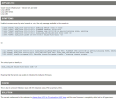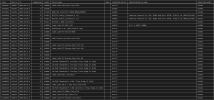Mellanox 4 LX - PCIe
- Thread starter furfix
- Start date
You are using an out of date browser. It may not display this or other websites correctly.
You should upgrade or use an alternative browser.
You should upgrade or use an alternative browser.
Here it is:
Code:
# dmidecode 3.4
Getting SMBIOS data from sysfs.
SMBIOS 3.2.0 present.
Table at 0x73A5F000.
Handle 0x0000, DMI type 0, 26 bytes
BIOS Information
Vendor: American Megatrends Inc.
Version: 1.D0
Release Date: 08/23/2023
Address: 0xF0000
Runtime Size: 64 kB
ROM Size: 32 MB
Characteristics:
PCI is supported
BIOS is upgradeable
BIOS shadowing is allowed
Boot from CD is supported
Selectable boot is supported
BIOS ROM is socketed
EDD is supported
5.25"/1.2 MB floppy services are supported (int 13h)
3.5"/720 kB floppy services are supported (int 13h)
3.5"/2.88 MB floppy services are supported (int 13h)
Print screen service is supported (int 5h)
8042 keyboard services are supported (int 9h)
Serial services are supported (int 14h)
Printer services are supported (int 17h)
USB legacy is supported
BIOS boot specification is supported
Targeted content distribution is supported
UEFI is supported
BIOS Revision: 5.17
Handle 0x0001, DMI type 1, 27 bytes
System Information
Manufacturer: Micro-Star International Co., Ltd.
Product Name: MS-7C77
Version: 1.0
Serial Number: Default string
UUID: 8847732e-cfae-4219-ab80-2cf05d7bf62d
Wake-up Type: Power Switch
SKU Number: Default string
Family: Default string
Handle 0x0002, DMI type 2, 15 bytes
Base Board Information
Manufacturer: Micro-Star International Co., Ltd.
Product Name: MEG Z490I UNIFY (MS-7C77)
Version: 1.0
Serial Number: K717347478
Asset Tag: Default string
Features:
Board is a hosting board
Board is replaceable
Location In Chassis: Default string
Chassis Handle: 0x0003
Type: Motherboard
Contained Object Handles: 0
Handle 0x0003, DMI type 3, 22 bytes
Chassis Information
Manufacturer: Micro-Star International Co., Ltd.
Type: Desktop
Lock: Not Present
Version: 1.0
Serial Number: Default string
Asset Tag: Default string
Boot-up State: Safe
Power Supply State: Safe
Thermal State: Safe
Security Status: None
OEM Information: 0x00000000
Height: Unspecified
Number Of Power Cords: 1
Contained Elements: 0
SKU Number: Default stringYes, and I enabled the options SR-IOV, VT-d, iommu and ROM Bar on the BIOS.So BIOS appears latest.
Wish to have some bucks to just buy an small pc and run this card in Baremetal
Did you try these?I'd start with changing CPU type tox86-64-v2-AES.
Then I'd try changing theVersionof theq35machine type. Lastly I'd look intovIOMMU/VirtIO.
x86-64-v2-AES, checked. Same issue.
vIOMMU, tried with Intel and Virtio, and same issue.
q35 to be honest, I tried only with Version 8 and latest, and same result.
I understand the card supports both Physical and Virtual Functions, like virtual switch...wondering if I'm missing something with the VFs and that is screwing the passthrough to the VM.
vIOMMU, tried with Intel and Virtio, and same issue.
q35 to be honest, I tried only with Version 8 and latest, and same result.
I understand the card supports both Physical and Virtual Functions, like virtual switch...wondering if I'm missing something with the VFs and that is screwing the passthrough to the VM.
While reviewing your problem - I noticed something interesting in the Datasheet of your motherboard. They describe the (single) PCI-E slot as a "Graphics Interface". This leads me to think that possibly you are suffering from what is described in the PVE wiki as:
The only way we would have of testing my theory would be to insert a different PCI device (maybe you have another spare graphics card lying around?) & put it in the PCI-E slot & see if you can pass that through to a VM.
Maybe another test; I understand that you tried the above with a Debian VM. Did it boot in the end? I understand that you were unable to use the ethernet card in that VM, but the question is does it show up at all in the VM with
Some motherboards can't pass through GPUs on the first PCI(e) slot by default, because its vBIOS is shadowed during boot up. You need to capture its vBIOS when it is working "normally" (i.e. installed in a different slot), then you can move the card to slot 1 and start the vm using the dumped vBIOS.
The only way we would have of testing my theory would be to insert a different PCI device (maybe you have another spare graphics card lying around?) & put it in the PCI-E slot & see if you can pass that through to a VM.
Maybe another test; I understand that you tried the above with a Debian VM. Did it boot in the end? I understand that you were unable to use the ethernet card in that VM, but the question is does it show up at all in the VM with
lspci ?that's a good point. unfortunately I don't have any other PCIe device I could use for testing it.While reviewing your problem - I noticed something interesting in the Datasheet of your motherboard. They describe the (single) PCI-E slot as a "Graphics Interface". This leads me to think that possibly you are suffering from what is described in the PVE wiki as:
The only way we would have of testing my theory would be to insert a different PCI device (maybe you have another spare graphics card lying around?) & put it in the PCI-E slot & see if you can pass that through to a VM.
Maybe another test; I understand that you tried the above with a Debian VM. Did it boot in the end? I understand that you were unable to use the ethernet card in that VM, but the question is does it show up at all in the VM withlspci?
What I've tried about Debian is to install it, and it hangs forever in "Detecting Network Devices" during the installation. Later today I will try again, but without the PCIe attached during the installation, and I will add it once it's installed, to see more specific why it can't be detected by Debian.
My card runs quite well in a x4 also. It’s worth a try, I would say. Also propose disable sr-vio or activate virtual nice and use those instead. Also remove nic from any VMbR and reboot without it in a Vmbr before passthrough.that's a good point. unfortunately I don't have any other PCIe device I could use for testing it.
What I've tried about Debian is to install it, and it hangs forever in "Detecting Network Devices" during the installation. Later today I will try again, but without the PCIe attached during the installation, and I will add it once it's installed, to see more specific why it can't be detected by Debian.
I believe not. The important point is that the device you try to passthrough must not share an IMMOU group ID with another device.Would be that a problem?
I have one last thing you could try. Try changing the BIOS type for the VM from
OVMF to SeaBIOS. You may have problems with the specific OS you are trying (IDK) but with a regular Debian VM there is no problem. I remember seeing passthrough issues being VM BIOS dependent.In another season of this show, I followed these instructions and I enabled one VF per port, and I can passtrhough them without any issue.
https://pve.proxmox.com/wiki/PCI(e)_Passthrough#_sr_iov
# echo 1 > /sys/bus/pci/devices/0000:01:00.0/sriov_numvfs
# echo 1 > /sys/bus/pci/devices/0000:01:00.1/sriov_numvfs
I still need to figure it out how to assign permantly a MAC address, beacause my ISP doesn't like me changing the MAC on every reboot and if I can make it, probably I will keep it like that. My hopes are gone to be able to passthrough the physical ports to the VM.
and if I can make it, probably I will keep it like that. My hopes are gone to be able to passthrough the physical ports to the VM.
https://pve.proxmox.com/wiki/PCI(e)_Passthrough#_sr_iov
# echo 1 > /sys/bus/pci/devices/0000:01:00.0/sriov_numvfs
# echo 1 > /sys/bus/pci/devices/0000:01:00.1/sriov_numvfs
I still need to figure it out how to assign permantly a MAC address, beacause my ISP doesn't like me changing the MAC on every reboot
I gave up. Yesterday I went bed like 4am.I disabled SRIOV from BIOS and tried, but same error… and I was happy with at least be able to use a VF, but netmap just made it impossible. either with emulated or native drivers, zenarmor blocked everything, so i went back again to a soft bridge. Im very frustrated.Great that works. I think SR-Iov is fantastic with VFs.
But if you prefer without:
Did you try disabling SR-IOV on NIC firmware, reboot, then passing through?
Code:
~# mlxconfig -d /dev/mst/mt4117_pciconf0 s SRIOV_EN=FALSE
Device #1:
----------
Device type: ConnectX4LX
Name: MCX4121A-ACA_Ax
Description: ConnectX-4 Lx EN network interface card; 25GbE dual-port SFP28; PCIe3.0 x8; ROHS R6
Device: /dev/mst/mt4117_pciconf0
Configurations: Next Boot New
SRIOV_EN True(1) False(0)
Apply new Configuration? (y/n) [n] : y
Applying... Done!
-I- Please reboot machine to load new configurations.
~# mlxconfig -d /dev/mst/mt4117_pciconf0 s NUM_OF_VFS=0
Device #1:
----------
Device type: ConnectX4LX
Name: MCX4121A-ACA_Ax
Description: ConnectX-4 Lx EN network interface card; 25GbE dual-port SFP28; PCIe3.0 x8; ROHS R6
Device: /dev/mst/mt4117_pciconf0
Configurations: Next Boot New
NUM_OF_VFS 8 0
Apply new Configuration? (y/n) [n] : y
Applying... Done!
-I- Please reboot machine to load new configurations.Rebooted, tried again, but same error on booting:
Code:
mlx5_core0: WARN: wait_fw_init:733:(pid 0): Waiting for FW initialization, timeout abort in 100 sPossibly to reboot actual nic, maybe you must actually power down the power going to the nic, so that the nic itself restarts. So maybe a plug revival is required. IDK, but maybe check the number of VFs showing after a restart.Rebooted



